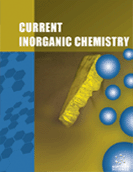Abstract
Background: The considerable interest in iron(III) oxo/hydroxo brigded polynuclear complexes stems from their relevance to diverse fields, from bioinorganic chemistry to molecular magnetic materials. The trinuclear oxo-centered carboxylato iron complexes have been extensively used as simple models in order to understand the magnetic interactions which have been interpreted in terms of the Heisenberg-Dirac-van Vleck irotropic spin Hamiltonian with antiferromagnetic interactions as well as non-Heisenberg interactions such as antisymmetric exchange.
Objectives: The main objective of this work was to study the magnetic interactions in triangular non oxocentered iron(III) complexes, a class of complexes which has been scarcely investigated so far.
Methods: Reactions of Schiff base ligands, OH-C10H6-CH=NC(CH2OH)3, H4L1, and OH-C6H4- CH=NC(R)(CH2OH)2 (R = CH3, H3L2; R = C2H5, H3L3) with 'basic' iron(III) benzoate salts afforded two trinuclear complexes, [Fe3(H2L1)3(O2CPh)3]∙2CH2Cl2 (1∙2CH2Cl2) and [Fe3(HL2)3(O2CPh)3] ∙0.45CH2Cl2∙0.40- H2O (2∙0.45CH2Cl2∙0.40H2O), and four octanuclear clusters, [Fe8(L3)8(HO2CPh)2]∙2.7CH2Cl2∙7.2H2O (3∙2.7CH2Cl2∙7.2H2O), [Fe8(L3)6(HL3)2 (O2CPh)2]∙3THF (4∙3THF), [Fe8(L3)6(HL3)2(O2CPh)2]∙6Me2CO (5∙6Me2CO) and [Fe8(L3)6(HL3)2 (O2CPh)2]∙4dmf (6∙4dmf). The crystal structures of 1-6 were determined by single-crystal X-ray crystallography. Variable-temperature magnetic susceptibility and magnetization measurements as well as Mossbauer spectra of 1-4 were undertaken. The study of the magnetic interactions within the trinuclear 1-2 was completed by X-band EPR spectroscopy.
Results: The molecular structure of the trinuclear complexes 1 and 2 possesses a [FeIII 3(µ2-OR)3(µ2-O2CPh)3]3+ core with the three FeIII atoms located at the vertexes of a scalene triangle; this triangular topology missing a central µ3-oxo bridge is rare in the literature. The octanuclear complexes 3-6 consist of seven corner-sharing [Fe2(µ2-OR)2] units, alternatively described as two sets of three corner-sharing [Fe2(µ2-OR)2] units in cisorientation linked through two µ2-OR atoms; this metal topology is novel in FeIII chemistry. The 57Fe Mössbauer spectra of 1-4 are consistent with the presence of high spin ferric ions in octahedral environments. The magnetic studies of the trinuclear 1 and 2 revealed antiferromagnetic interactions with isotropic exchange parameters consistent with literature values. EPR spectroscopy revealed that the ST = 1/2 state is highly anisotropic which is interpreted considering the non-Heisenberg terms zero field splitting and antisymmetric exchange. The magnetic studies of the octanuclear 3 and 4 revealed dominant antiferromagnetic interactions.
Conclusion: This work presents the use of Schiff base ligands in iron(III)/carboxylato chemistry which afforded two trinuclear non oxo-centered (1, 2) and four octanuclear (3-6) complexes. A detailed magnetic and spectroscopic (EPR, Mössbauer) study of the extremely rare triangular non oxo-centered iron(III) complexes 1 and 2 revealed the role of non Heisenberg interactions.
Keywords: Iron(III) clusters, magnetic studies, Schiff base ligands, crystal structures, Mössbauer spectroscopy, EPR spectroscopy, Non-Heisenberg interactions.
 28
28 2
2 2
2 1
1


